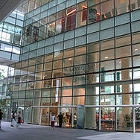

The National Library Building is an innovative ‘green’ building designed as a “Library for the Tropics” using bioclimatic design techniques.
Internationally recognised as an architectural icon and designed as a ‘green’ building, its deployment of various innovative ‘green’ features helps to keep the building operating in an energy-efficient way and to do its part for a more sustainable environment.
Key ‘green’ features include the use of bioclimatic vegetation and landscaping to improve the indoor thermal environment and a lighting control system that switches off lighting when there is sufficient natural light to illuminate the building interior, as detected by light sensors. The building is also heavily shaded to reduce solar heat gain through the facade. In supporting efforts towards environmental sustainability, NLB is one of the founding members of the Singapore Green Building Council.
Key Green Features
- Building is oriented away from the East-West sun, combined with sun-shading features on the West face of the building as an additional shield against solar heat gain and glare. Sun-shading features include the low-emissive double-glazing glass panel facade and large overhangs on the external facade
- Light shelves that extend into the library space reflect sunlight further into the building. This optimizes daylight and thus reduces the use of artificial lighting.
- Energy efficient features include daylight sensors that are used together with automatic blinds at the building facades, public toilets installed with motion sensors and energy efficient lightings that are switched on only when required after closure of the library.
- Use of rain sensors as part of the automatic irrigation system for rooftop gardens. Water efficient taps and cisterns are also used to conserve water.
- Extensive landscaping, sky terraces and roof gardens are utilized to lower local ambient temperature.
- Night setback for air-conditioning system in the library spaces after library operation hours with automated chiller controls.
- An open Plaza area between the two blocks, which allows natural ventilation and daylighting. Stack effect at the open Plaza (i.e. the air is drawn upward between the link bridges and in-between the two blocks).
- Energy monitoring via BMS (Building Management System).
Financial Savings
The ‘green’ concept fulfills NLB’s corporate social responsibility in being environmentally friendly. Besides the benefits of lower energy consumption and operating costs, the ‘green’ technologies have made the running of the National Library Building more efficient.
Our calculations show that we save an average of about 33% on the monthly energy bill compared to a similar building without the ‘green’ features. Hence, the long-term savings to be derived can be quite significant. The operational costswould have been higher if not for the ‘green’ features.
Awards & Accolades
For the considerable ‘green’ outcomes achieved, the National Library Building (NLB) has also won several awards.
In recognition of its environmental friendliness, it was awarded the Green Mark Platinum Award in May 2005. This is the highest honour for ‘green’ buildings in Singapore bestowed by the local Building and Construction Authority (BCA).
In August 2007, it also won First Prize in the ASEAN Energy Efficiency Award under the ‘New and Existing Building’ category.
In 2007, the National Library Building won the Singapore Silver Award in the Universal Design Award from BCA, for its wide spaces, good lighting, accessibility and clarity in way finding.
As a result of its ‘green’ fame, NLB has received many visitors from various countries, including the United States, Thailand, Indonesia and India, to look at the ‘green’ features of the National Library Building. These visitors have been impressed with the extent of planning and implementation of the ‘green’ features in the building while ensuring good indoor air quality. We also have visitors, including students and academics, from local and overseas educational institutions, interested in the ‘green’ aspects of the building.